The biggest ground war in human history took place in Europe from September, 1939 to May, 1945. The WWII timeline presented today by ORIENTAL REVIEW is the cortesy contribution by the American military historian Walter DuBlanica.
SEPTEMBER ,1939 to MAY,1940
Germany attacked Poland on September 1, 1939. A few days later Britain and France declare war on Germany. Western historians describe the September 1939 to May,1940 period as the “Phoney War” since very little fighting took place.
FRANCE
 When the Germans took Paris in the spring of 1940, they lost fewer troops then they did in attempting to take a building in Stalingrad defended by Sgt. Pavlov and his squad of a dozen Soviet soldiers. More French collaborated with the Germans then fought against them. The last German Iron Cross (equivalent of U.S. Congressional Medal of Honor) was awarded to a Frenchman in the Battle of Berlin . He was a member of the S.S. Charlemagne division which was annihilated by the Russians.
When the Germans took Paris in the spring of 1940, they lost fewer troops then they did in attempting to take a building in Stalingrad defended by Sgt. Pavlov and his squad of a dozen Soviet soldiers. More French collaborated with the Germans then fought against them. The last German Iron Cross (equivalent of U.S. Congressional Medal of Honor) was awarded to a Frenchman in the Battle of Berlin . He was a member of the S.S. Charlemagne division which was annihilated by the Russians.
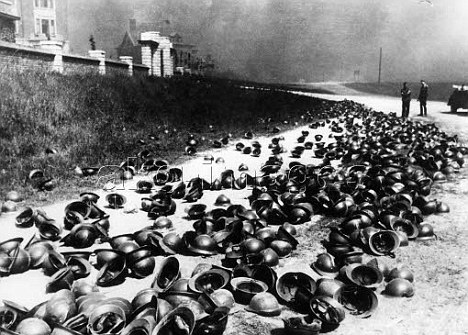
BRITAIN
The British losses were light. In the spring of 1940, the Germans attacked and 300,000 British troops abandoned their weapons and returned to Britain. They returned to Europe in force in June, 1944 during the invasion of France and the start of the Second Front. The fighting in France was on a much bigger scale then the fighting on the Italian peninsula in 1943 or North Africa in 1942/1943.
GERMANY INVADES the SOVIET UNION
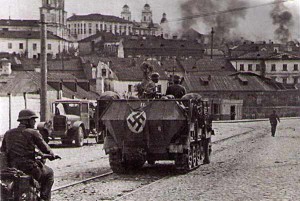
On June 22, 1941 Germany and its allies invade the Soviet Union. German allies include Austria, Italy, Hungry, Finland and Romania with a combined population of 170,000,000. In addition Germany had collaborators from all the countries of Europe except Britain. The battle order of the German S.S. divisions in the last year and a half of the war had more non Germans then Germans. The population of the Soviet Union was 190,000,000. Popular impression was that Germany would win the war in 6 weeks against the Soviet Union, given that their victory was so easy in Western Europe.
Germany suffered its first military defeat in the Battle of Moscow. The battle took place from November, 1941 to January, 1942 and insured that Germany could no longer win the war as initially anticipated. The Germans suffered 500,000 casualties in the battle. By March, 1942 the German casualties on the Eastern Front totaled 1,100,000. After 16 months in Russia, by November 1942 Germany sustained 2,000,000 casualties.
BATTLE of STALINGRAD
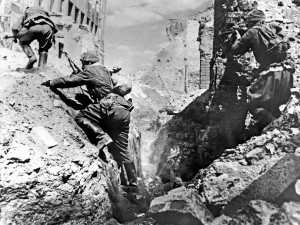
In August, 1942 the Germans amassed their best troops and approached Stalingrad with 1,250,000 men. Of this number only 30,000 ever got back home.
On November 19, 1942 the Russians encircled 330,000 German troops inside Stalingrad. Of this number, 94,000 survived and surrendered on January 31, 1943. Only 5,000 ever got home. During the battle the Russians set up a ticking clock reminding the Germans that every 7 seconds one of them is being killed. In the spring thaw of 1943 there were rivulets of blood flowing into the Volga River. This battle made it very clear that Germany would lose the war. The Battle of Stalingrad is referred to as the battle that changed the world. What if the Nazis had won?
BATTLE of AL ALAMAYN
The biggest battle in North Africa was fought by the British in November, 1942 at about the same time that the German army was being encircled in Stalingrad. The German losses at Al Alamayn were 1,000 killed and 9,000 captured or wounded. During this time period, the Germans had 3 divisions in North Africa and 160 divisions against the Russians. The United States lost 7,000 men killed in North Africa.
THE BATTLE of KURSK
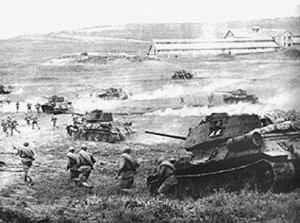 The Battle of Kursk which is located 350 miles south of Moscow took place in July 1943. In this 2-week-long battle the Germans lost 125,000 killed and 350,000 captured or wounded. The Kursk Front alone involved 2.500,000 Red Army and 1,000,000 German troops. By this time Russian intelligence penetrated the German high command and knew exactly their plan of attack weeks ahead of the battle. Marshall Zhukov ordered the Red Army a week ahead of time as to the day and hour and places they were to open fire on. Kursk was Germany’s last attempt at an offensive on the Eastern Front. It failed. At this point in the war, Russia had 5 times as much artillery as did the Germans.
The Battle of Kursk which is located 350 miles south of Moscow took place in July 1943. In this 2-week-long battle the Germans lost 125,000 killed and 350,000 captured or wounded. The Kursk Front alone involved 2.500,000 Red Army and 1,000,000 German troops. By this time Russian intelligence penetrated the German high command and knew exactly their plan of attack weeks ahead of the battle. Marshall Zhukov ordered the Red Army a week ahead of time as to the day and hour and places they were to open fire on. Kursk was Germany’s last attempt at an offensive on the Eastern Front. It failed. At this point in the war, Russia had 5 times as much artillery as did the Germans.
INVASION of SICILY
In July/August of 1943 160,000 U.S. and British troops invaded Sicily and defeated 60,000 German troops.
OPERATION BAGRATION & SECOND FRONT in FRANCE
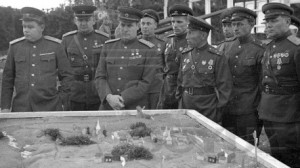 On June 22,1944 ( 3 years to the day after Germany invaded Russia ) the Russians ( Marshall Zhukov’s 1st Byelorussian Front ) launched a massive attack in Byelorussia code named “Operation Bagration” against German Army Group Centre. During a single week against Army Group Centre German battle casualties were 480,000 men. On the Second Front in France during the 6 weeks after D-Day (June/July 1944) total German losses were 140,000 men. On a weekly basis this is a ratio of about 20 to 1. In Just 12 days, Army Group Centre lost 25 of its 43 divisions. In 5 weeks the Russian Army moved 200 miles west to the gates of Warsaw . For the Germans the destruction of Army Group Centre was a defeat greater than Stalingrad. In addition to Army Group Centre there were German Army Group North, German Army Group North Ukraine and German Army Group South Ukraine. They were defeated in short order. The Hungarian and Romanian armies were routed in similar fashion. Interesting, Hungry with a population of 10,000,000 lost as many soldiers on the Eastern Front (150,000) as did the U.S. and British in Europe and North Africa. Marshall Rokossovsky’s 2nd Byelorussian Front takes East Prussia and the Baltic countries, Marshall Konev’s 1st Ukrainian Front takes Prague, Marshall Malinovsky’s 2nd Ukrainian Front takes Budapest and Vienna and Marshall Tolboukin’s 3rd Ukrainian Front takes Romania.
On June 22,1944 ( 3 years to the day after Germany invaded Russia ) the Russians ( Marshall Zhukov’s 1st Byelorussian Front ) launched a massive attack in Byelorussia code named “Operation Bagration” against German Army Group Centre. During a single week against Army Group Centre German battle casualties were 480,000 men. On the Second Front in France during the 6 weeks after D-Day (June/July 1944) total German losses were 140,000 men. On a weekly basis this is a ratio of about 20 to 1. In Just 12 days, Army Group Centre lost 25 of its 43 divisions. In 5 weeks the Russian Army moved 200 miles west to the gates of Warsaw . For the Germans the destruction of Army Group Centre was a defeat greater than Stalingrad. In addition to Army Group Centre there were German Army Group North, German Army Group North Ukraine and German Army Group South Ukraine. They were defeated in short order. The Hungarian and Romanian armies were routed in similar fashion. Interesting, Hungry with a population of 10,000,000 lost as many soldiers on the Eastern Front (150,000) as did the U.S. and British in Europe and North Africa. Marshall Rokossovsky’s 2nd Byelorussian Front takes East Prussia and the Baltic countries, Marshall Konev’s 1st Ukrainian Front takes Prague, Marshall Malinovsky’s 2nd Ukrainian Front takes Budapest and Vienna and Marshall Tolboukin’s 3rd Ukrainian Front takes Romania.
BATTLE of BERLIN
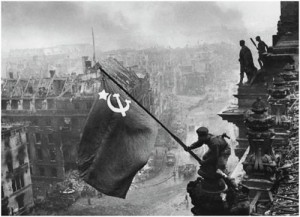 In January/February, 1945 the Russians advanced from the Vistula river in Poland to the Oder river in Germany. The offensive was started earlier at a plea from Winston Churchill to counter the successful German offensive in the Ardennes ( the Battle of the Bulge in which 18,000 U.S. troops were killed and 60,000 wounded). The Ardennes battle took place in Belgium. The 3 Russian Marshalls, Zhukov, Rokossovsky and Konev had an army of 2,500,000 men versus a German army of 1,000,000. On April 16th, the Russian army under field commander Marshall Chuikov opened fire with 40,000 guns. This broke the last German resistance before Berlin with German losses of 50,000 men killed. During the course of the Berlin operation, the Germans lost 460,000 killed and 480,000 captured. In just 16 days the Russians took Berlin and the war was over. The victory made possible by the fact that the Soviet army materially and spiritually surpassed the enemy.
In January/February, 1945 the Russians advanced from the Vistula river in Poland to the Oder river in Germany. The offensive was started earlier at a plea from Winston Churchill to counter the successful German offensive in the Ardennes ( the Battle of the Bulge in which 18,000 U.S. troops were killed and 60,000 wounded). The Ardennes battle took place in Belgium. The 3 Russian Marshalls, Zhukov, Rokossovsky and Konev had an army of 2,500,000 men versus a German army of 1,000,000. On April 16th, the Russian army under field commander Marshall Chuikov opened fire with 40,000 guns. This broke the last German resistance before Berlin with German losses of 50,000 men killed. During the course of the Berlin operation, the Germans lost 460,000 killed and 480,000 captured. In just 16 days the Russians took Berlin and the war was over. The victory made possible by the fact that the Soviet army materially and spiritually surpassed the enemy.
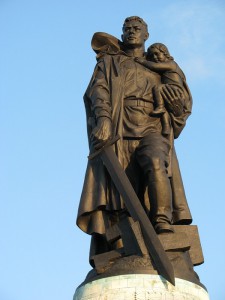
RUSSIAN SOLDIER
The best descriptions of the Russian soldier come from German soldiers, German generals, British generals and a Russian Jew who was a correspondent through out the war.
Vassili Grossman wrote:
I am deeply affected by the genuine spirit of sacrifice among the Russian soldiers. At war a Russian soldier puts on a white shirt and dies like a saint. At the front there is patience and a resignation to unthinkable hardships. This is the patience of a strong people .This is the patience of a great army. The greatness of the Russian soul is incredible.
A German soldier at Stalingrad wrote:
The Russians are not human but some kind of cast iron creatures.
In his book, Willy Reese writes about Germans attitude after being on the Eastern Front. He noted that German veterans profess an admiration for the Russian soldier which was seldom conceded to his Western counterpart.
A German veteran aptly described the war in the West as “proper sport” while the war in the East was unmitigated disaster.
A distinguished German staff officer wrote after the war in which he describes his virtues:
The greatest asset the Russian Army possessed was the Russian soldier. He is patient and enduring beyond imagination, incredibly brave and courageous. A feature of the Russian is his utter contempt for life or death—so incomprehensible to a Westerner.
The British General Giffard Martel had this to say about the Russian soldier:
Their bravery on the battlefield is beyond dispute but their most outstanding feature is their astonishing strength and toughness.
The last Hero of the Soviet Union medal was awarded to a Russian soldier in the final days of the Battle of Berlin. He heroically rescued a German woman and her 4 year old daughter and brought them to safety. During the rescue he was mortally wounded and died a few days later. When asked to whom they may report this heroic action, he replied—no one, my entire family was killed during the war.
ORIENTAL REVIEW thanks Mr.Dublanica for his kind contribution and suggests to the readers an outstanding and detailed flash presentation about the operations on the Eastern Front in 1941-1945:



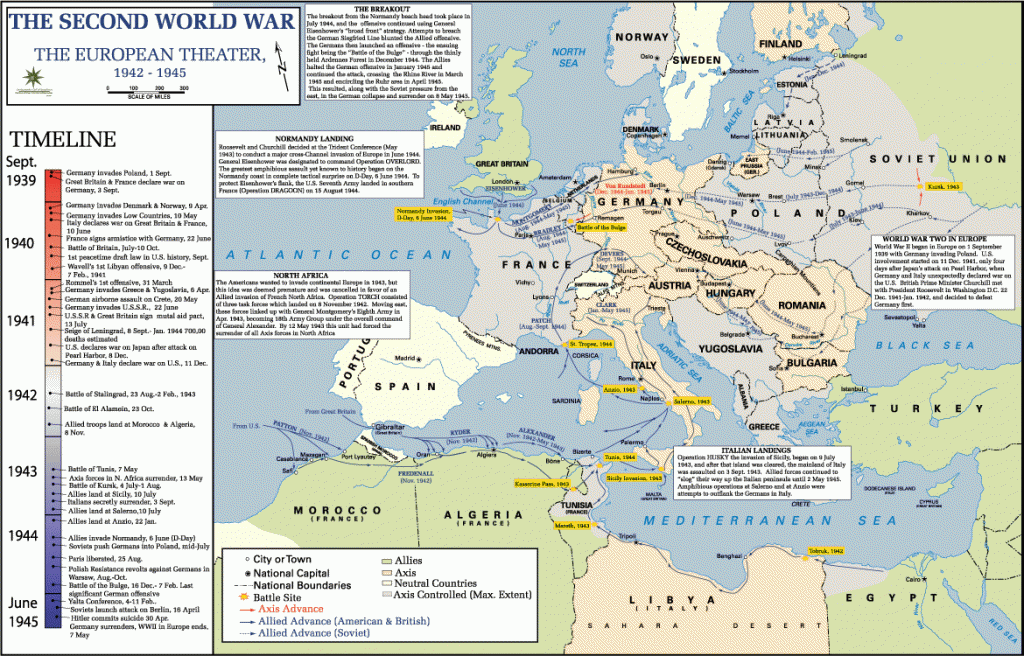
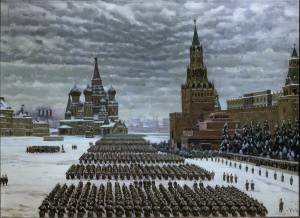













There is no greater country on earth then mighty russia!